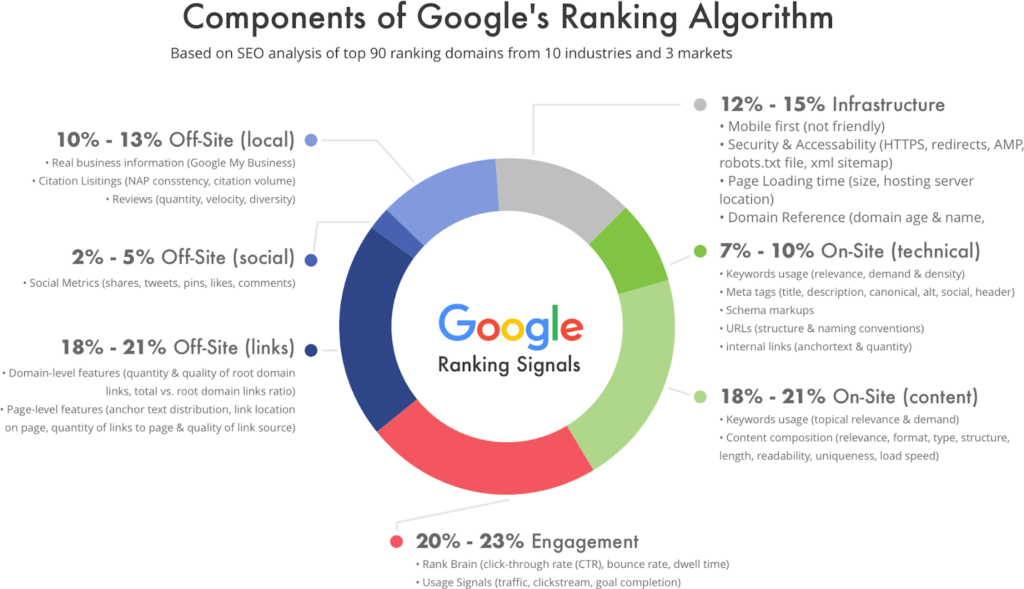
Table of Contents
- Introduction
- What is SEO?
- What are the different types of SEO?
- Black, white, and gray hat practices
- What are some ideal SEO practices?
- Google’s SEO guidelines
- Key takeaways
- Conclusion
- FAQs
Search engine optimization (SEO) is a set of practices that help your website get better visibility on search engines. However, there is no one-size-fits-all rule for SEO strategies; there are guidelines available that are different for different search engines. Since there are no set rules, how you go about your SEO strategy is totally up to you. Depending on your risk appetite and overall website, there are different types of SEO that you can consider.
What is SEO?
Search engine optimization is a set of activities performed by website owners to organically promote their websites. This helps them gain higher visibility when their audience searches for the same or related topics. Basically, you can boost your website traffic by employing SEO strategies. This does not focus on the inorganic or direct traffic. It includes everything from keyword integration, backlinking to tracking search rankings and user engagement and optimizing the website’s interface. So, when planning your SEO strategy, you need to make sure to pick the right path for your website’s success.
What are the different types of SEO?
You can consider different routes when creating your SEO strategy. All these routes require you to pay attention to different parts of your website. You can choose many or just a couple of strategies, depending on what is suitable for your website. The image below broadly classifies where the focus of each of these SEO types lies.

1. Technical SEO
This is exactly what the name implies. This type of SEO takes care of the technical factors that affect the SEO rankings of a website and/or its pages. This includes making the website and web pages accessible to the search engine’s crawlers, and by extension, making it easier to be indexed.
2. On-page SEO
On-page SEO helps make the website user-friendly, so it deals with the front-end of the website. Since rankings are determined at the page level, every page of the website needs to be optimized. This includes optimizing page titles, H1 tags, headings, and images, as well as formatting the pages. Pay attention to these factors, and you are sure to get better rankings.
3. Content SEO
This can be achieved by improving the quality of content you display on your website. Two things determine good content: its ability to engage users so that they come back for more and whether it is simple enough for the search engines to grasp. Using long-tail keywords, doing thorough keyword research, ensuring that the content is of optimal length (to retain attention), and adding schemas (small words in your HTML code for Google to understand your content easily) are a few practices you can use to elevate content quality and visibility.
4. Off-page SEO
When you think of promotion, you are thinking of off-page SEO. This type of SEO has everything to do with organic promotion techniques for your website. It includes getting your website backlinks from more popular sources; this helps increase the crawlers’ as well as users’ trust in your website and its content. You can also promote your website on social media.
5. Local SEO
If you have a local business and want more people to know about it, you can try using this SEO strategy. To make your local store more visible in local searches, you can create a Google My Business account containing all your business details. This technique is location-based and is used to specifically target local customers.
6. Mobile SEO
You guessed it right! This type of SEO is somewhat like on-page SEO, wherein you make web pages more user-friendly. Only this time, it is for mobile devices. Optimizing your website for mobiles means that users should be able to view the website seamlessly.
7. E-commerce SEO
Optimizing e-commerce websites can be challenging, as they contain a number of individual components. You can start off by optimizing the homepage and the categories page. After this, you can optimize your product pages based on search volumes. Also, make sure that the images and videos used are of optimum quality.
Black, white, and gray hat practices
Now that you have a fair idea about the different types of SEO, let’s understand what black, white, and gray SEO hats are. These hats basically describe how your practices stand on a scale of ethics. In theory, heroes wear white hats and villains wear black. However, in the SEO world, you’re not a villain for employing certain black or gray hat practices. If you know how to take calculated risks, then you can always benefit from any of these practices.
1. Black hat SEO
Black hat SEO practices can trick the search engine into thinking that your website is better than others in the same category. This comes with the risk of being penalized by the search engine. These practices generally exploit the algorithm’s weaknesses to gain better ranks. Building spammy or paid links, cloaking the content to show two different versions to the audiences and crawlers, and keyword stuffing are some instances of black hat SEO practices. All of this may cause your website to lose ranking or worse, get banned. The results of these shortcuts are also short-lived, and are, therefore, best avoided.
2. White hat SEO
The most ethical of the lot, these practices include relevant content, proper keyword research, and earning links from popular websites. These practices are included in Google’s guidelines for better search engine optimization. However, the results take time, so you need to be patient. Your patience will definitely pay off because these practices will help you build goodwill with the search engines. White hat SEO will yield higher rewards at lower risks.
3. Gray hat SEO
As the name suggests, it is a mix of both White hat and black hat techniques. This is used only when you need to see quick results. And since there are no hard-and-fast rules as to what is prohibited, there has been a rise in the usage of gray hat practices. This includes clickbait, content duplication, too many website redirections, and more. These tactics may end up giving poor results, as the quality of traffic may be compromised.
What are some ideal SEO practices?
Like we discussed above, there are no right or wrong SEO practices. However, to be ahead in the ranking game, you must adhere to SEO best practices, because poor SEO tactics or malpractices may be flagged by the search engine. The table below iterates certain good and poor SEO practices that are followed around the globe:
| Good SEO practices | Poor SEO practices |
| Proper keyword research | Keyword stuffing |
| Backlinking trusted, popular websites | Not using internal or external linking |
| Optimum images, titles, headings, loading time | Redirecting to suspicious websites |
| Optimized user interface | A heavy website that takes forever to load |
| Original content that adds value | Cloaked content |
| Tracking ranking progress and optimizing areas where improvements are needed | Clickbait with low or no relevance |
| Updated and relevant content | Unfixed technical errors |
Google’s SEO guidelines
Google has elaborate guidelines for SEO strategy. Let’s find out what they are.

1. Avoid keyword overuse
Using a keyword over and over will not help. Instead, it will only make your content seem repetitive. Google takes the time that is spent on your web page as an indicator of relevance. This means, the more time someone spends on your page, the more relevant they consider your business. This, in turn, can earn you a better ranking.
2. Use unique keywords
Using unique keywords will help you drive quality traffic to your website. This also means that the audience will find your content relevant because they specifically searched for it. And since the keyword would be unique, you may not have much competition for visibility.
3. Create original content
Keep your audience happy and the Google rankings will follow. If you create unique, engaging content, it will help boost traffic to your website and improve rankings. Duplicating content is a strict no-no. And, of course, keep it relevant.
4. Use quality links
Having external links on your website is important, but the quality of these links is also vital. Broken links or links that redirect too much will reduce the audience’s interest in your website. This will drastically decrease the amount of time people spend on your website. Include links from popular websites. This will help build trust with Google and increase your website’s credibility.
5. Update content regularly
Certain content tends to become irrelevant over time, so it is crucial to continuously update your website’s content. This will help in not only retaining your existing audience but also attracting new customers.
6. Follow suggestions on Google Search Console
Google gives suggestions about SEO best practices on Search Console, so make sure you incorporate them in your SEO strategy. The search engine actively looks for cloaked, which is a violation of its guidelines. So it is best to avoid employing this black hat practice at all costs.
7. Optimize speed
If your website loads too slowly, people will definitely bounce off, and that is a bad sign. If this happens on a regular basis, then Google will deem your website irrelevant and your ranking will go down with it. Hence, it is important to ensure fast and flawless browsing on your website.
Key takeaways
- SEO is important to improve the visibility of your website.
- All websites need SEO to gain traffic and be more discoverable.
- There are many types of SEO, and you can use a combination of many or some, based on your preferences.
- Broadly, there are three types of SEO: technical, on-page, and off-page.
- White hat SEO is the most sensible option with higher rewards and low risk.
- Avoid bad practices if you want to build goodwill with search engines in the long run.
- Follow Google’s guidelines for the most optimal SEO strategy for your website.
Conclusion
SEO is an indispensable part of any web-based content, as it helps drive traffic and generate leads. You need to pick the right type of SEO strategy for your website to get the best out of search engines. The three hats need to be carefully scrutinized to understand what is best suited to your website. It is almost advisable to not use black hat SEO techniques, as unethical practices may cause you to lose your website and all the hard work you put into building it. White hat SEO techniques are slow to act but, eventually, will give you the best results.

FAQs
Search engine optimization is a set of activities performed by website owners to organically promote their websites by improving their ranking on search engines. SEO practices are aimed at increasing a website’s visibility in a sea of similar websites.
A website’s ranking is dependent on individual web pages. It is determined through content quality and uniqueness, optimization of the various components of the website, keyword integration, etc.
There are three main types of SEO, namely: technical, on-page, and off-page SEO. A few subcategories of SEO include local SEO, mobile SEO, content SEO, and e-commerce SEO.
Often confused as types of SEO, these are terms to describe good and bad practices of SEO. White hat techniques are good practices that abide by the search engine’s guidelines. Black hat SEO refers to practices that are used by websites to trick the algorithm, and are, therefore, risky. Gray hat SEO is a mix of white and black hat techniques, which helps the websites gain quick results with a moderate amount of risk.
Source
It is advisable to use white hat techniques to build your website’s ranking. It takes time but is definitely worth the wait. White hat techniques help you build trust with your audience as well as the search engine. They do not carry the risk of the website getting banned or suspended. However, sometimes white hat techniques may not be as effective, in which case you may want to tweak your strategy for better results.
By following good practices and different types of SEO, you can create the perfect SEO plan. These include extensive keyword research, creating unique content that contains popular keywords, avoiding keyword stuffing, integrating long-tail keywords, optimizing the titles of web pages, optimizing the website’s loading time, creating relevant content, optimizing URLs so that they are indexable, optimizing web pages for mobile, creating engaging social media content to promote the website, and much more.
Latest Blogs
Explore how Google’s 2025 AI search updates triggered ranking chaos. Learn actionable strategies to adapt your SEO for AI Overviews, zero-click searches, and SERP volatility. Stay ahead now.
Learn how to rank on AI search engines like ChatGPT, Perplexity, and Gemini by optimizing your content for authority, structure, and relevance. Stay ahead in AI-driven search with this strategic guide.
Explore the best healthcare SEO services for your medical practice. Improve online visibility and effectively reach more patients in need of your services.
Get your hands on the latest news!
Similar Posts

Artificial Intelligence
6 mins read
The Role of AI in Digital Marketing: AI Article Generators Transforming Content Creation

Artificial Intelligence
4 mins read
How AI Content Creator Is Shaping the Future of Digital Content

Digital Marketing
3 mins read